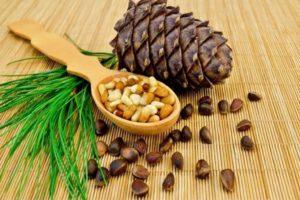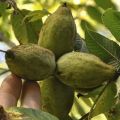How to plant and grow a walnut, rules of care and methods of reproduction
There are several known ways to plant a walnut. In any case, it is important to carry out the preparatory and planting work correctly. In order for the tree to actively develop and form yields, it is necessary to organize proper care and create the required conditions. It is important to be aware of the first symptoms of a problem while growing a tree. To preserve all the useful components in nuts, the crop must be harvested on time, observing some rules.
Content
- 1 Technical characteristics of the tree
- 2 How to choose a variety for different regions of Russia
- 3 Is it possible to germinate a walnut at home in a pot
- 4 Landing technology
- 5 When the seedling is rooting
- 6 How is a planted tree looked after?
- 7 Fight against diseases and harmful insects
- 8 How to cover a walnut for the winter?
- 9 Why is it necessary to transplant a walnut
- 10 How to transplant a fruit tree correctly
- 11 When a young nut begins to bear fruit
- 12 The main difficulties with growing walnut
Technical characteristics of the tree
The walnut is a sturdy and large tree with a sprawling, domed crown and powerful root system. The trunk of many trees is straight, reaches 24 meters in height, and the bark is ashy. Walnuts begin to bloom in May. At the same time, elongated leaves of a light green color bloom. Pollination occurs with the participation of the wind. The fruits can be oblong or round. The walnut kernel, divided by partitions, is covered on top with two halves of a hard brown shell.
How to choose a variety for different regions of Russia
A large number of walnut varieties are distinguished, which differ in ripening boundaries, resistance to cold and disease, productivity, and the taste of the fruits themselves. In central Russia, it is best to grow nuts with early ripening of fruits, high resistance to diseases and pests, resistance to winter cold and sudden changes in temperature. Suitable varieties are Ideal, Aurora, Graceful, Giant, Dessert, Abundant, Zarya Vostoka.
Is it possible to germinate a walnut at home in a pot
You can germinate a walnut tree for planting at home, and then an adult strong plant is transplanted to a permanent place. They start work in the last days of April.
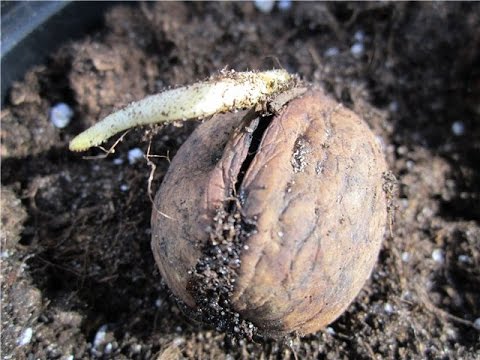
Step-by-step action plan:
- A fertile soil mixture is prepared from sod land, peat and humus.
- For planting, choose a wide container with a depth of 30 cm.
- A drainage layer is laid out on the bottom of the pot, and then the prepared soil.
- Make a hole 7 cm deep and lay the nut with the edge up. Cover with earth and watered.
- The container with the nuts is removed in a warm, bright place.
After 2.5 weeks, the first shoots should appear. If further growing at home is planned, then as it grows, the tree is transplanted into a large container. Transplanting a seedling into open ground is carried out a year after planting. By this time, the length of the stem reaches 20 cm. A planting hole is made 1 meter deep and fertilizers are placed. Then carefully remove the plant from the pot along with an earthen clod. The central root is cut by a third.
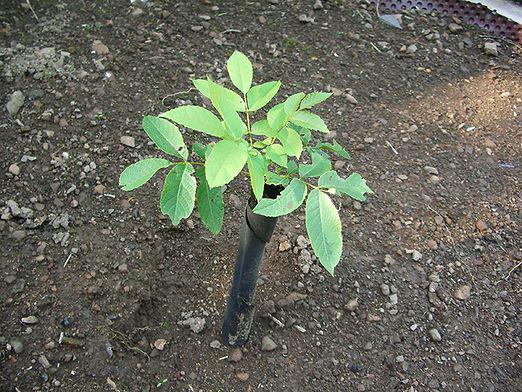
Landing technology
An adult walnut tree is tall, spreading, the trunk reaches 5 meters in diameter, the roots are powerful and occupy a large area. All these characteristics indicate that for planting in the ground, you need to choose a spacious place, away from other crops and buildings. The distance between two mature walnut trees must be at least 5 meters. You can plant a tree in spring or autumn.
If the climate in the region is cool, then it is preferable to engage in planting work in the spring before the start of sap flow. In the southern regions, the walnut tree is planted in the garden in the fall.
Any soil is suitable for planting a nut, as long as there is a sufficiently good drainage layer and neutral acidity. In the case of a predominance of clay composition in the earth, peat and compost are introduced. Saplings do not develop well in the shade, so they choose a place where the sun's rays fall without obstacles. On the site, groundwater should not pass close to the earth's surface. You can propagate the culture by seeds, seedlings, layering or grafting. Each method has its own advantages and disadvantages.
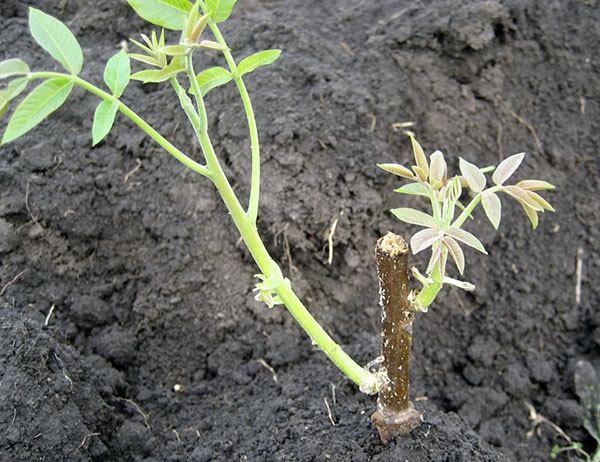
Seeds
The most common but long-term method of propagating walnuts is through seeds. Fresh, just fallen nuts with a smooth shell without damage are suitable. Initially, the seeds should germinate. The stratification procedure accelerates this process. Moistened sawdust or river sand is poured into a wide container with holes at the bottom. Then the nuts are laid out so that the rib is at the top, and they are covered with the rest of the substrate.
Thick-skinned nuts stratify for three months at temperatures from +1 to +6 degrees. If the nutshell is thin, then 1.5 months is enough. In this case, the air temperature should be closer to +18 degrees.
Seeds are planted in mid-spring, when the soil warms up well enough, or in mid-September.
Many experienced gardeners find it best to remove the shells before planting. This will allow seedlings to appear faster.

3.5 weeks before sowing, a planting hole is dug with a depth of 58 cm. A nutrient mixture is poured onto the bottom of the hole, which includes manure, superphosphate and wood ash. Nuts are placed in holes to a depth of 13 cm.If the seed size is too small, then the depth should be less - 8 cm. You can dig a trench into which the nuts are spread at intervals of 22 cm. Under favorable conditions, a sprout will appear after 11 days.
Saplings
It is better to plant walnut seedlings in the spring:
- Two-year-old seedlings are suitable for growing.
- The thickness of the trunk near the root collar must be at least 1 cm.
- The central root of the seedling is shortened to 42 cm, the cut is processed with clay.
- Damaged, rotten or dried roots are removed.
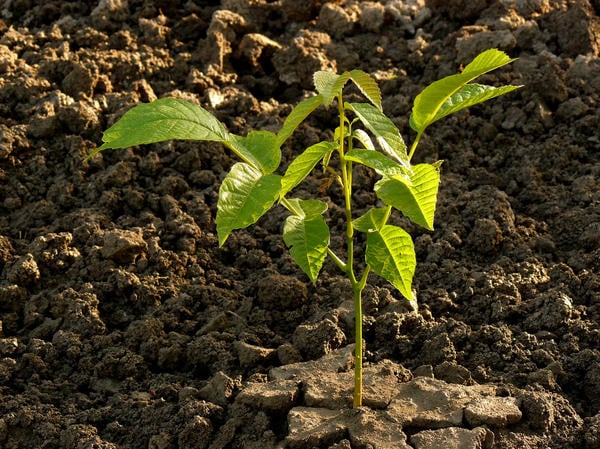
Planting with green cuttings will take little time. A hole 90 cm deep and 48 cm wide is dug in the selected area. The seedlings are placed in the hole, the root branches are straightened and covered with earth so that the root collar remains 3.5 cm above the surface. The soil around the trunk is compacted, watered and mulched.
Grafting
Grafting of a nut culture is carried out by budding. The cut-off flap from the scion branch should be large.This will ensure that the eye has sufficient moisture and nutrients. The shield is placed under the bark of the rootstock.
But the winter cold leads to the death of most of the grafted buds, so the seedlings are dug up and stored in a basement at a temperature of +1 degrees.
In the spring, when the soil warms up to +11 degrees, the seedlings are planted in a greenhouse. As soon as the seedlings reach a height of 130 cm, they are transplanted to a permanent place.

Layers
Propagation of walnuts by cuttings is considered a popular method. In this case, the plant is planted in the last days of April or in November. The tree is watered two days before the procedure. The incisions are made with a sharp, disinfected knife. Cut off the stalk, which is located on the southern side of the tree, at a height of 5 meters from the ground. Using a knife, several cuts are made on a smooth surface, after which they remove the formed shield with a good eye. Its size should be about 3 cm.
The cut flap is placed on the rootstock and the place is wrapped with foil. After two weeks, the petiole will change color, become light gray. Saplings planted this way grow quickly.
When the seedling is rooting
For good rooting of seedlings, it is necessary to create conditions. The cuttings are planted in a greenhouse, where the air humidity should be 98%, and the air temperature should be +28 degrees. In this case, the soil should be warmed up to +25 degrees. After 2.5 months, rooting will occur.

They help speed up the rooting of top dressing. Immediately after planting the seedlings, add superphosphate granules. After a month, fertilizers are used, which contain nitrogen, phosphorus and potassium, and after another 1.5 months, fertilization is repeated.
How is a planted tree looked after?
Walnut care is carried out all year round. Cultivation is not complete without fertilizing the soil, watering, weeding, pruning branches, treating diseases and pests.
Watering
After planting in open ground, the tree should be watered frequently and abundantly. One root should take about 30 liters of water. It is recommended to moisturize twice a month. If the weather is hot, water more often. As soon as the tree reaches 4 meters, watering is reduced. In rainy weather, they do without additional irrigation.

Soil fertilization
For better crop development and increased immunity, it is required to fertilize the soil twice a year:
- In the spring and early June, there is a need for nitrogen components. Nitrogen should not be added during the fruiting period, since an excess of the component leads to the development of fungal infections.
- In the summer, it is recommended to carry out foliar feeding of the plant with phosphate and potassium fertilizers with the addition of trace elements.
- In the fall, fertilizers rich in potassium and phosphorus must be applied. Top dressing is placed in the near-trunk zone.
Green manures (peas, lupine, oats) are planted around the tree, which enrich the soil with nutrients. With the onset of autumn, the soil is dug up.
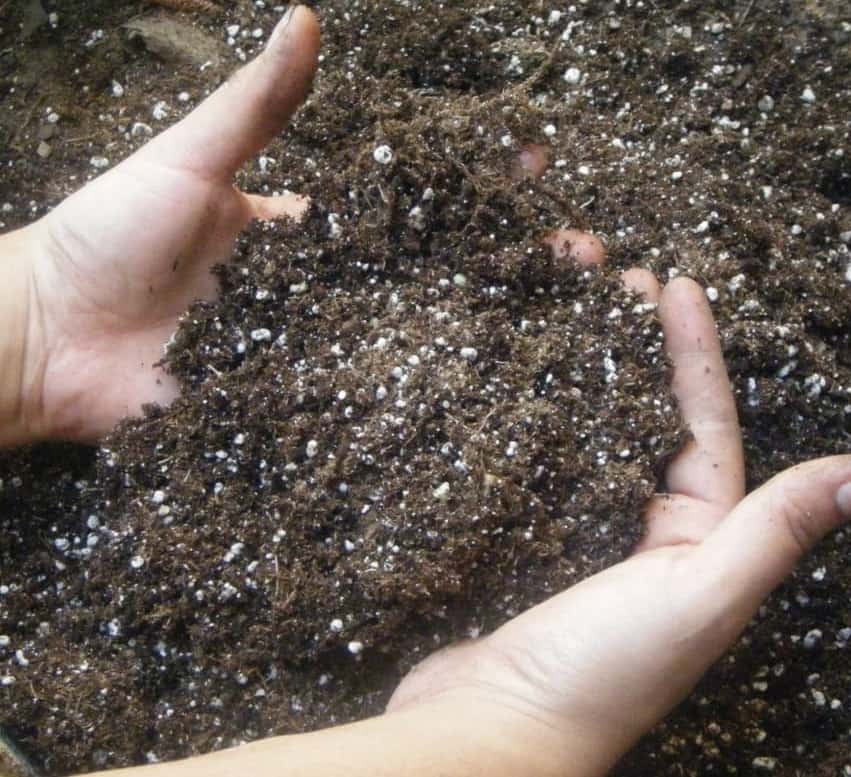
Pruning
At the end of March, the first sanitary pruning is carried out, provided that the weather is warm. In case of cold weather, the procedure should be postponed. Before the start of sap flow, you need to have time to remove frozen, dry, damaged branches. Sanitary pruning is repeated at the end of August. At this time of the year, sick, dry branches are clearly visible, which should be disposed of.
Dry, broken and diseased branches should be removed in late autumn.
Pruning is done with a sterile, sharp garden knife or secateurs. The first time the procedure is carried out after the tree reaches a height of 1.6 meters. At the same time, the formation of the crown is also carried out. 11 main branches are left on the tree, the rest are shortened by 22 cm.The formation is carried out 4 seasons in a row.

Fight against diseases and harmful insects
To protect the walnut from the attack of pests and infections, they are sprayed with special solutions twice a year.The first treatment is carried out before fruiting, the second - in the fall, after the leaves fall. In the spring, before the start of sap flow, the crown is treated with a solution of Bordeaux liquid or copper sulfate. The same solutions are used to treat the tree in the fall, after the leaves fall
Frequent diseases that a walnut infects are: bacteriosis, brown spot, root cancer, fire blight. In all cases, spots appear on the leaves, they dry, curl and fall off. The yield decreases, and in some cases the situation threatens the complete death of the plant. Treatment is carried out with drugs such as "Vectra", "Strobi".

The most commonly attacked pests include the American white butterfly, wart mite, nut moth, moth and aphid. To cope with insects help such drugs as: "Lepidocid", "Dendrobacillin", "Aktara", "Akarin", "Decis", "Actellik".
How to cover a walnut for the winter?
Many varieties of walnuts do not tolerate winter frosts well. Already at a temperature of -26 degrees, they can die. Young seedlings need shelter. The trunk of the trees is wrapped in warm fabric material, and the near-trunk zone is mulched with manure. After the snow falls, a snowdrift is thrown around the trunk.
Why is it necessary to transplant a walnut
The walnut should be transplanted when it is planted near the house or near other cultivated plants. A transplant is carried out before the walnut tree is 4 years old.
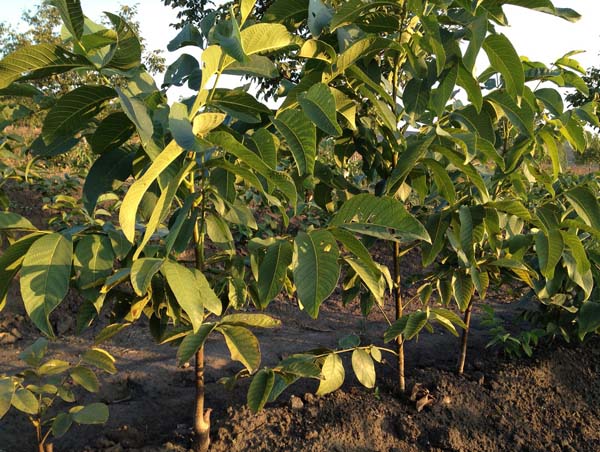
In order for the tree to grow and bear fruit further, digging and transportation is carried out with extreme caution. If the root system is damaged, the plant may die.
How to transplant a fruit tree correctly
The process of transplanting a walnut tree to a permanent place involves the fulfillment of a number of conditions:
- the place should be away from buildings and other trees;
- the day before the procedure, the plant is watered so that the soil is wet to a depth of 50 cm;
- the roots are cut, leaving a length of 45 cm;
- it is better to do the transplant in the afternoon.
It is important to decide on the timing of transplanting seedlings. It is forbidden to do this in summer. In this case, the roots do not adapt to the new place and will rot.
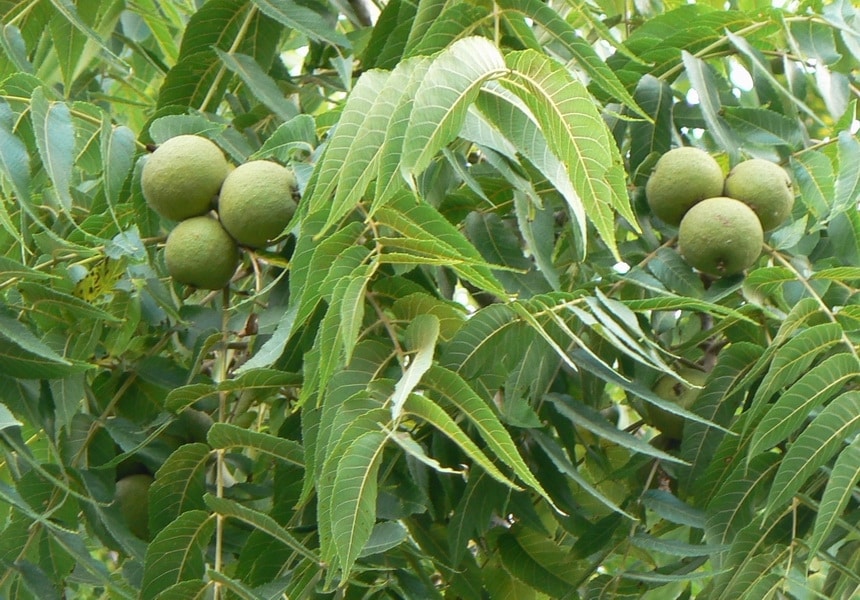
Transplant timing
Transplanting should be done in the spring (in April), until the buds appear or in the fall after all the leaves fall (in October). In this case, the soil should warm up, and the air temperature at night should not drop below +10 degrees.
Site preparation
A planting hole is dug in a new place. Its size will depend on the age of the tree, the volume of the earthy coma and the quality of the soil. The denser the soil and the more mature the plant, the larger the size of the dug hole should be. At the bottom, a drainage layer with a height of 16 cm is established. Then they begin to prepare the nutrient soil. For this, the top layer of soil removed from the pit is combined with humus, compost, ammophos, wood ash and superphosphate. The resulting soil mixture is poured into a hole, leaving a depression equal to the root system of the seedling.

Procedure technology
The transplant procedure is not complicated, but it requires the fulfillment of some rules:
- seedlings are placed in the center of the prepared hole so that the root collar is slightly above ground level;
- next to the seedling, two pegs are driven in, to which the plant is tied;
- fill the voids with earth;
- a small side of the earth is made around the trunk, which will prevent water from leaking during irrigation;
- the near-trunk zone is mulched;
- at the last stage, the plant is abundantly watered with warm water.
If all the rules are followed, it will be possible to transplant the tree without damaging the roots, and proper care will ensure rapid rooting.

When a young nut begins to bear fruit
How many years the nut will begin to bear fruit depends on many factors. A tree grown from a fruit begins to form a crop in the 7-9th year.With proper care, the first nuts will appear on the purchased seedlings already in the 3-4th year. To increase yields in the future, the first 3-4 years of growth should be controlled so that the tree gains a sufficiently branched green mass. If there are few lateral branches, then their tops are cut into 2-3 buds.
Ripening period
Nuts begin to ripen at different times. The defining role is played by the variety:
- the harvesting of an early ripe harvest begins in early September;
- mid-season varieties begin to ripen at the end of September;
- ripening of late varieties of walnuts occurs in mid-October.
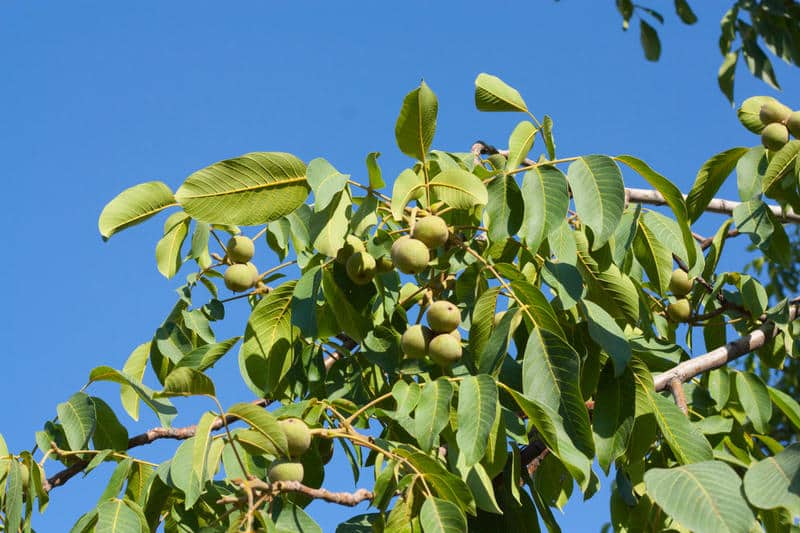
The climate of the region also plays an important role. In places with cold weather conditions, fruit ripening is delayed for 2-2.5 weeks.
Signs of fruit ripeness
For a crop to be stored for a long time, it must be harvested on time. Signs of fruit ripening, which begin to appear already in August, include:
- shedding nuts from branches;
- darkening and cracking of the green shell of the nut;
- the nut shell becomes brown.
The harvest does not ripen evenly, so the collection of nuts is carried out in several stages.

Harvesting rules
When can you start harvesting? Nuts begin to ripen by the end of summer, early autumn. Suitable for storage are those fruits in which the green peel has begun to crack. It is not recommended to collect fruits from the tree, since they do not accumulate the entire stock of useful components. It happens that the nut is ripe, but does not fall from the trees. Therefore, a long pole comes to the rescue, which is carefully hit on the branches. The collected nuts are cleaned of pericarp and other debris.
The main difficulties with growing walnut
Improper care, non-compliance with the rules for planting or transplanting walnuts, as well as other unfavorable factors lead to the fact that the tree begins to dry, yield decreases, and other problems appear.
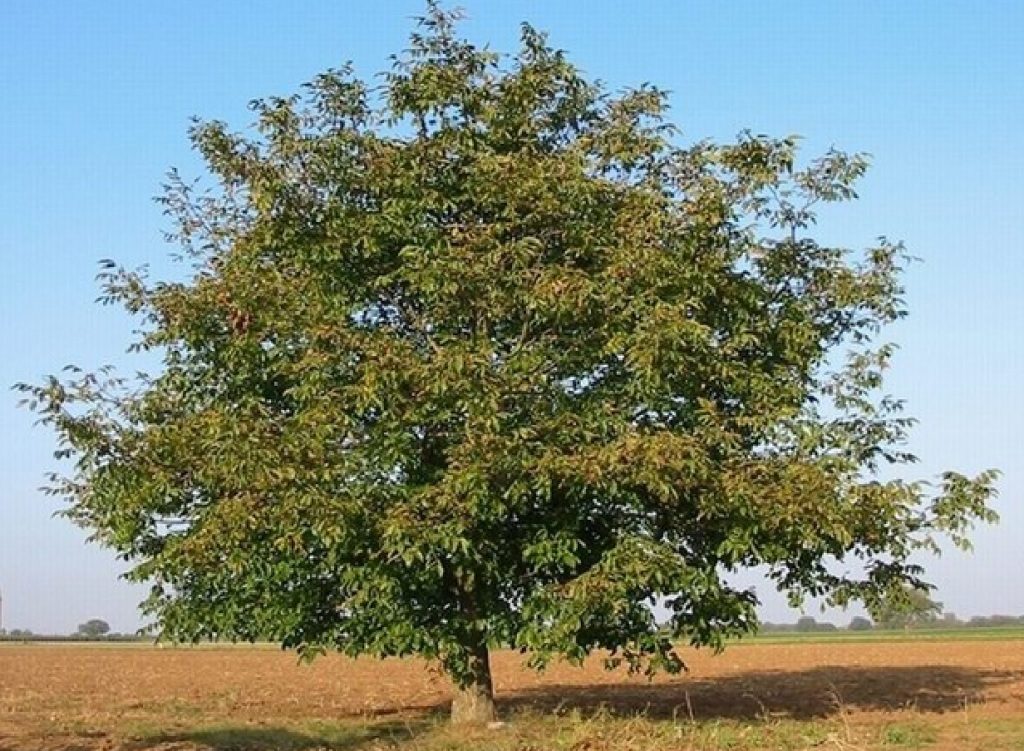
The tree does not bear fruit
There are several reasons why the tree does not bear fruit:
- too thick crown;
- an abundance of lateral branches without flowering;
- heavy rains during the flowering period or low air humidity lead to disruption of the pollination process;
- pest attack or infection;
- incorrectly performed trimming procedure;
- lack or excess of fertilizers.
All these reasons indicate that it is necessary to properly organize the care of the culture.
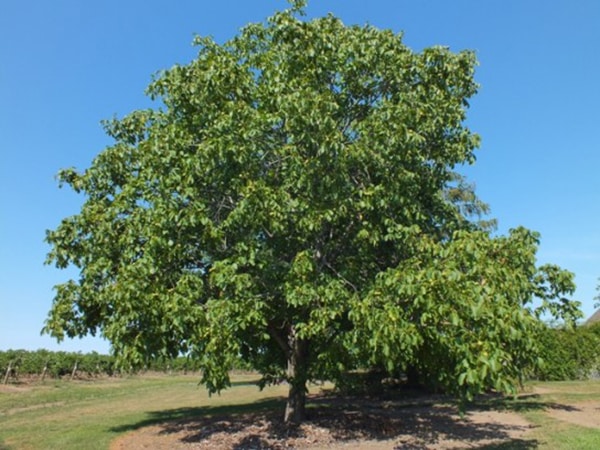
Does not grow
Walnut requires some attention. The growth of the seedling stops as a result of the following adverse factors:
- early planting in open ground;
- bad soil;
- improper insecticide treatment;
- lack of a garter;
- damage to the root system during transplant.
It is necessary to deal with the problem in time in order to preserve the culture and get a large harvest.
Leaves and branches dry
Fungal diseases are a common cause of drying of leaves and twigs. Plant immunity decreases due to frost damage, acid rain or hail, excessive watering, excess nitrogen.
